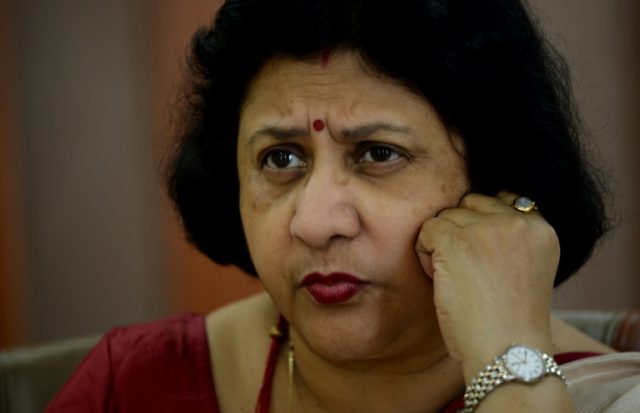Mumbai (AFP) – The first female head at one of India’s biggest banks says a ruling forcing firms to appoint women directors to boards has eased chronically lopsided gender ratios — but warns too many firms are still failing to embrace diversity.
State Bank of India chairwoman Arundhati Bhattacharya told AFP that the regulator’s moves to get rid of the “old boys’ network” and demand women were appointed to boards had led to posts being filled by family members. However, she said she was fine with that if they have the ability.
India changed its laws in 2013 to force publicly listed companies to have at least one woman among their board directors — around 96 percent of whom were men at the time.
After the Securities and Exchange Board of India (SEBI) regulator issued a comply-or-be-fined deadline in March 2015, firms scrambled to act, drafting in wives, daughters or other relatives to fill the spots.
“A lot of women who are getting inducted after SEBI’s rule are family members. And this isn’t a problem as long as they understand the business.
“But we believe it is important to get an outsider’s perspective,” said Bhattacharya, who joined SBI in 1977 and rose through the ranks to the top of the country’s largest and oldest commercial lender.
As hiring managers complain about a lack of talented women candidates for board-level jobs, her view is that they simply have not looked hard enough.
– Changing attitudes –
“Even today I find many people saying we don’t find properly qualified women. What they’re saying is they are not networked enough.”
The problem is not only at the top — across the country only 27 percent of women work, according to the International Labour Organization, which ranked India 120th among the 131 nations on female labour participation in 2013.
“Seventy-five percent of these appointments are non-independent and drawn from family members, thereby failing to bring any diversity to corporate boardrooms,” Pranav Haldea, managing director of Prime Database, a firm that compiles capital markets data, told AFP.
Bhattacharya cites the challenge of changing attitudes in a society that still largely views women as primary caretakers and says having children leads many to fall off the corporate ladder.
To address the problem, in 2014 she brought in two-year sabbaticals to allow women to take career breaks without falling out of the workforce.
“We want to ensure that men also take up their portion of responsibilities during child care and women continue working from home, so they don’t face drawbacks or fall behind,” she said.
As the only woman chief of a public sector bank, Bhattacharya cuts a lonely figure, although Chanda Kochhar and Shikha Sharma head the private ICICI and Axis banks.
Bhattacharya, named the world’s fifth most powerful woman in finance by Forbes Magazine, has won praise from investors for bringing about a digital transformation at the 210-year-old former Imperial Bank of India.
– Alarm bells –
However, she has faced criticism, too, notably over the problem of bad loans weighing down India’s lenders, seen as a core threat to the stability of the fast-growing economy.
She has also led a public fight against disgraced businessman Vijay Mallya, who became a symbol of the bad loan problem after fleeing the country in March owing $1.34 billion.
The SBI branded the defunct Kingfisher Airlines founder a “willful defaulter” and called for his arrest before going to court to try to recover its dues.
Yet Raghuram Rajan, the outgoing governor of the central Reserve Bank of India, has continued to sound alarm bells over public banks’ mountain of soured assets.
“The process of cleaning up bad loans from Indian banks is a welcome move,” Bhattacharya said.
“However, we need sufficient means of resolving these. Resolving them and putting them on track is not an easy task.”
Some say the plague of bad loans, which have dented SBI profits, led Bhattacharya to miss out on replacing Rajan as RBI chief, a post ultimately awarded to insider Urjit Patel.
The question on investors’ minds now is whether Bhattacharya, who reached the retirement age of 60 this year, will stay on at SBI after her term ends in September.
Either way, she says, over the course of her career, the notion that women could not be trusted with an organisation’s future has been firmly buried.
“That is a thing of the past. Things are changing now.”

COMMENTS
Please let us know if you're having issues with commenting.